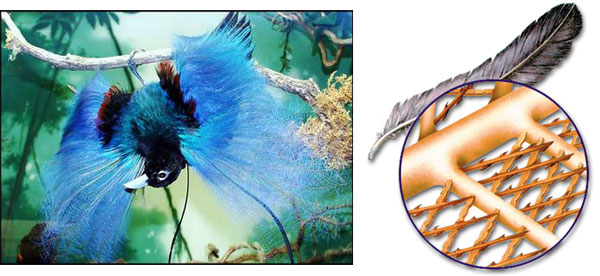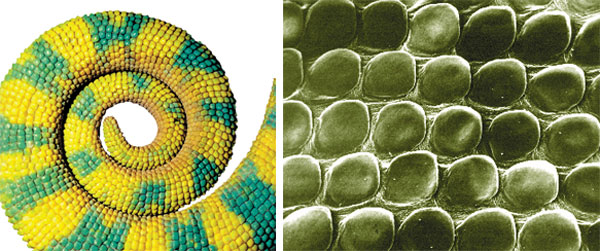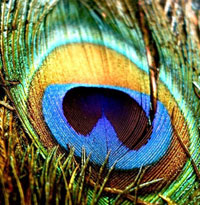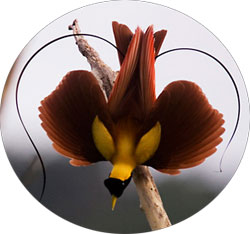Bird Feathers
Feathers, which have an extremely complex design and aerodynamic characteristics, are unique to birds. The claim that bird feathers evolved from reptile scales is completely groundless.
The bodies of reptiles are covered with scales, whereas the bodies of birds are covered with feathers. Since evolutionists consider reptiles the ancestors of birds, they are obliged to claim that bird feathers have evolved from reptile scales. However, there is no similarity between scales and feathers.
 |
FEATHERS AND SCALES The theory of evolution is compelled to propose that feathers that are perfectly designed for flight evolved from reptile scales. Feathers and scales, however, are completely different from each other in terms of genetic origins and embryologic development. Above is the detailed structure of a bird feather and on the side are the scales of a reptile. |
A professor of physiology and neurobiology from the University of Connecticut, A.H. Brush, accepts this reality, although he is an evolutionist: "Every feature from gene structure and organization, to development, morphogenesis and tissue organization is different (in feathers and scales)."36 Moreover, Prof. Brush examines the protein structure of bird feathers and argues that it is "unique among vertebrates."37
 |
Close-up of reptile scales. As we see clearly, scales are overlapping hard skin parts. They have no resemblance whatsoever to feathers. |
There is no fossil evidence to prove that bird feathers evolved from reptile scales. On the contrary, "feathers appear suddenly in the fossil record, as an 'undeniably unique' character distinguishing birds" as Prof. Brush states.38 Besides, in reptiles, no epidermal structure has yet been detected that provides an origin for bird feathers.39
 |
THE PEACOCK AND DARWIN The feathers of peacocks are a very explicit example of design. They make a human being think in what a beautiful and perfect form God created living things. However, Darwin became "sick" every time he saw this beauty. |
 |
STRUCTURE OF FEATHERS Bird feathers develop on either side of hollow shafts that are directly fastened on to the animal's skeletal bones. This structure is completely different from the scales of reptiles, the so-called ancestors of birds. Scales have nothing to do with skeletal bones. |
The "Feathered dinosaur fossils discovered in China" story, which came to light in 1996 amidst great media propaganda was totally unfounded, and it was realised in 1997 that the Sinosauropteryx fossil in question possessed no structures resembling feathers.40
On the other hand, when we examine bird feathers closely, we come across a very complex design that cannot be explained by any evolutionary process. The famous ornithologist Alan Feduccia states that "every feature of them has aerodynamic functions. They are extremely light, have the ability to lift up which increases in lower speeds, and may return to their previous position very easily". Then he continues, "I cannot really understand how an organ perfectly designed for flight may have emerged for another need at the beginning".41
The design of feathers also compelled Charles Darwin to ponder over them. Moreover, the perfect aesthetics of the peafowl's feathers had made him "sick" (his own words). In a letter he wrote to Asa Gray on April 3, 1860, he said "I remember well the time when the thought of the eye made me cold all over, but I have got over this stage of complaint..." And then continued: "... and now trifling particulars of structure often make me very uncomfortable. The sight of a feather in a peacock's tail, whenever I gaze at it, makes me sick!"42
Footnotes
36) A. H. Brush, "On the Origin of Feathers", Journal of Evolutionary Biology, Vol. 9, 1996. S. 132.
37) A. H. Brush, "On the Origin of Feathers", S. 131.
38) A. H. Brush, "On the Origin of Feathers", S. 133.
39) A. H. Brush, "On the Origin of Feathers", S. 131.
40) "Plucking the Feathered Dinosaur", Science, Band 278, 14 November 1997, S. 1229.
41) Douglas Palmer, "Learning to Fly", (Review of The Origin of and Evolution of Birds by Alan Feduccia, Yale University Press, 1996), New Scientist, Band 153, 1 Mrz 1997, S. 44.
42) Norman Macbeth, Darwin Retried: An Appeal to Reason, Boston: Gambit, 1971, S. 101.
- An Outdated View: The Theory of Evolution
- The Origin of Life
- The Design in the Protein
- The Design in the Cell
- Genetic Information
- The Design in Nature
- Miller's Experiment
- The Natural Selection Misconception
- Mutations
- Irreducible Complexity
- Impasse of Intermediate Forms
- The Cambrian Period
- Fish and Amphibians
- Coelacanth Misconception
- Reptiles
- Birds and Reptiles
- Archaeopteryx Misconception
- Bird Feathers
- The Origin of Mammals
- Living Fossils
- The Tale of Man's Evolution
- Australopithecus
- Homo Erectus
- A Lost Human Race: Neanderthals
- The Collapse of the Family Tree
- The Bipedalism Impasse
- False Faces
- Piltdown Scandal
- Why is Evolution Defended?
- The Obvious Truth: Creation
